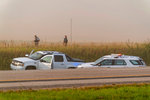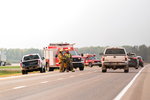


ROSTHERN, Saskatchewan (AP) — The final suspect in a stabbing rampage in which 10 people were killed in and around a Canadian Indigenous reserve died after being arrested by police Wednesday following a three-day manhunt, authorities said. One official said he died of self-inflicted injuries.
Myles Sanderson, 32, was caught on a highway near the town of Rosthern in the province of Saskatchewan as officers responded to a report of a stolen vehicle being driven by a man armed with a knife, the Royal Canadian Mounted Police said.
Officers forced Sanderson’s vehicle off the road and into a ditch, Assistant Commissioner Rhonda Blackmore, commander of the RCMP in Saskatchewan, said at a news conference. He was detained and a knife was found inside the vehicle she said.
She said Sanderson went into medical distress after he was arrested. She said CPR was attempted on him before an ambulance arrived. She said emergency medical personnel then took him to a hospital, where he was pronounced dead.
“All life-saving measures that we are capable of were taken at that time," she said.
Blackmore gave no details on the cause of death. “I can’t speak to the specific manner of death,” she said.
But an official, who spoke on condition of anonymity, earlier said Sanderson died of self-inflicted injuries, without giving any further details.
Video and photos from the scene showed a white SUV off to the side of the road with police cars all around. Airbags had deployed in the SUV. Some photos and video taken from a distance appeared to show Sanderson being frisked.
His death came two days after the body of his brother, 30-year-old Damien Sanderson, was found in a field near the scene of their rampage, which also wounded 18 people. Police are investigating whether Myles Sanderson killed his brother.
Blackmore said that with both men dead, authorities will find it hard to figure out what set off the rampage.
“Now that Myles is deceased we may never have an understanding of that motivation,” she said.
But she started off her remarks that the news conference by stressing that people in Saskatchewan can rest easier.
“This evening our province breathing a collective sigh of relief,” Blackmore said.
Later, she added: “I hope that this brings them closure. I hope they can rest easy knowing that Myles Sanderson is no longer a threat to them.”
Some family members of the victims arrived at the scene Wednesday, including Brian Burns, whose wife and son were killed.
“Now we can start to heal. The healing begins today, now,” he said.
The stabbing rampage raised questions about why Myles Sanderson — an ex-con with 59 convictions and a long history of shocking violence — was out on the streets in the first place.
He was released by a parole board in February while serving a sentence of over four years on charges that included assault and robbery. But he had been wanted by police since May, apparently for violating the terms of his release, though the details were not immediately clear.
His long and lurid rap sheet also showed that seven years ago, he attacked and stabbed one of the victims killed in the weekend rampage, according to court records.
Canadian Public Safety Minister Marco Mendicino said there will be an investigation into the parole board's assessment of Sanderson.
“I want to know the reasons behind the decision" to release him, Mendicino said. “I'm extremely concerned with what occurred here. A community has been left reeling."
Investigators have not given a motive for the bloodshed.
The Saskatchewan Coroner’s Service said nine of those killed were from the James Smith Cree Nation: Thomas Burns, 23; Carol Burns, 46; Gregory Burns, 28; Lydia Gloria Burns, 61; Bonnie Burns, 48; Earl Burns, 66; Lana Head, 49; Christian Head, 54; and Robert Sanderson, 49, One was from Weldon, 78-year-old Wesley Patterson.
Authorities would not say how the victims might be related.
Mark Arcand said his half-sister Bonnie and her son Gregory were killed.
“Her son was lying there already deceased. My sister went out and tried to help her son, and she was stabbed two times, and she died right beside him,” he said. “Right outside of her home she was killed by senseless acts. She was protecting her son. She was protecting three little boys. This is why she is a hero.”
Arcand rushed to the reserve the morning of the rampage. After that, he said, “I woke up in the middle of the night just screaming and yelling. What I saw that day I can’t get out of my head."
As for what set off the violence, Arcand said: “We’re all looking for those same answers. We don’t know what happened. Maybe we’ll never know. That’s the hardest part of this."
Court documents said Sanderson attacked his in-laws Earl Burns and Joyce Burns in 2015, knifing Earl Burns repeatedly and wounding Joyce Burns. He later pleaded guilty to assault and threatening Earl Burns’ life.
Sharna Sugarman, who was organizing a GoFundMe for the victims, questioned the parole board for releasing him and wondered why Sanderson was still on the loose so many months after he was deemed “unlawfully at large.”
“That’s just egregious to me,” said Sugarman, a counselor who counted one of the stabbing victims as a client. “If they claim that they’ve been looking for him, well, you weren’t looking that hard.”